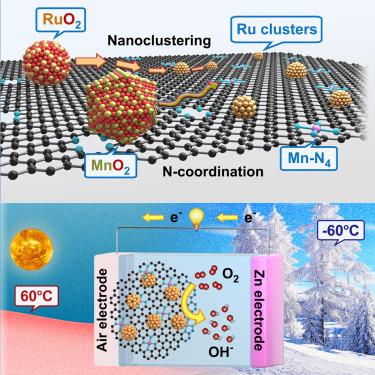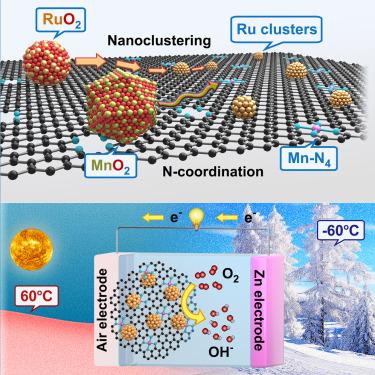活化 Ru 纳米团簇,在水性宽温锌-空气电池中实现强效氧还原
IF 17.3
1区 材料科学
Q1 MATERIALS SCIENCE, MULTIDISCIPLINARY
引用次数: 0
摘要
水基宽温锌-空气电池(AWT-ZAB)有望满足极端气候条件下(-60°C 至 60°C)快速增长的能源需求。然而,阴极氧还原反应(ORR)动力学易受温度波动的影响。在此,我们提出了一种由 Ru 纳米团簇和邻近的 Mn-N4 分子(RuNC@Mn-N4)组成的高活性、高持久性 ORR 催化剂。RuNC@Mn-N4 的半波电位达到 0.925 V,超过了已知的 Ru 基电催化剂,而且在 50,000 次循环后衰减极小。在 AWT-ZAB 中,与 Pt/C 相比,RuNC@Mn-N4 在 60°C 时的峰值功率密度(Pmax)为 320.6 mW cm-2,在 -20°C 至 -60°C 时的峰值功率密度(Pmax)高出 1.5 至 3 倍。我们的机理研究揭示了由 Mn-N4 分子激活的 Ru 纳米团簇的缺电子特性,这使得 O2 的吸附/解离得以优化,并促进了中间产物的低温质子化,从而产生了快速的宽温 ORR 动力学。这项研究为精心设计具有最佳 AWT-ZAB 性能的 ORR 电催化剂奠定了基础。本文章由计算机程序翻译,如有差异,请以英文原文为准。


Activating Ru nanoclusters for robust oxygen reduction in aqueous wide-temperature zinc-air batteries
Aqueous wide-temperature zinc-air batteries (AWT-ZABs) have the potential to meet the fast-growing energy demand in extreme climates (−60°C to 60°C). However, cathodic oxygen reduction reaction (ORR) kinetics are susceptible to temperature fluctuations. Herein, we present a highly active and durable ORR catalyst composed of Ru nanoclusters and neighboring Mn-N4 moieties (RuNC@Mn-N4). The RuNC@Mn-N4 achieved a half-wave potential of 0.925 V, surpassing known Ru-based electrocatalysts, with minimal decay after 50,000 cycles. In AWT-ZABs, the RuNC@Mn-N4 delivered a peak power density (Pmax) of 320.6 mW cm−2 at 60°C and a 1.5- to 3-fold higher Pmax at −20°C to −60°C compared to Pt/C. Our mechanistic investigations unveil the electron-deficient nature of Ru nanoclusters activated by the Mn-N4 moieties, which enables the optimized adsorption/dissociation of O2 and facilitates low-temperature protonation of intermediates, resulting in speedy wide-temperature ORR kinetics. This study sets the stage for the deliberate design of ORR electrocatalysts for optimal AWT-ZAB performance.
求助全文
通过发布文献求助,成功后即可免费获取论文全文。
去求助
来源期刊

Matter
MATERIALS SCIENCE, MULTIDISCIPLINARY-
CiteScore
26.30
自引率
2.60%
发文量
367
期刊介绍:
Matter, a monthly journal affiliated with Cell, spans the broad field of materials science from nano to macro levels,covering fundamentals to applications. Embracing groundbreaking technologies,it includes full-length research articles,reviews, perspectives,previews, opinions, personnel stories, and general editorial content.
Matter aims to be the primary resource for researchers in academia and industry, inspiring the next generation of materials scientists.
 求助内容:
求助内容: 应助结果提醒方式:
应助结果提醒方式:


